Curatorial Essay: Renaissance Paintings Exhibition at Two Rivers
VerifiedAdded on 2023/06/15
|9
|1433
|402
Essay
AI Summary
This essay explores the multifaceted responsibilities of a museum curator in organizing a special exhibition focused on Renaissance paintings at the Two Rivers Gallery. It highlights the curator's role in managing museum layouts, fundraising, artifact acquisition, and educational outreach. The essay delves into the selection of five landmark paintings from the Renaissance period, including Leonardo Da Vinci's Mona Lisa and The Last Supper, Raphael's Sistine Madonna and The School of Athens, and Michelangelo's The Last Judgement, providing descriptions and historical context for each. The paper concludes by emphasizing the significance of these artworks in representing the high culture of the Renaissance and their potential to engage and excite visitors.
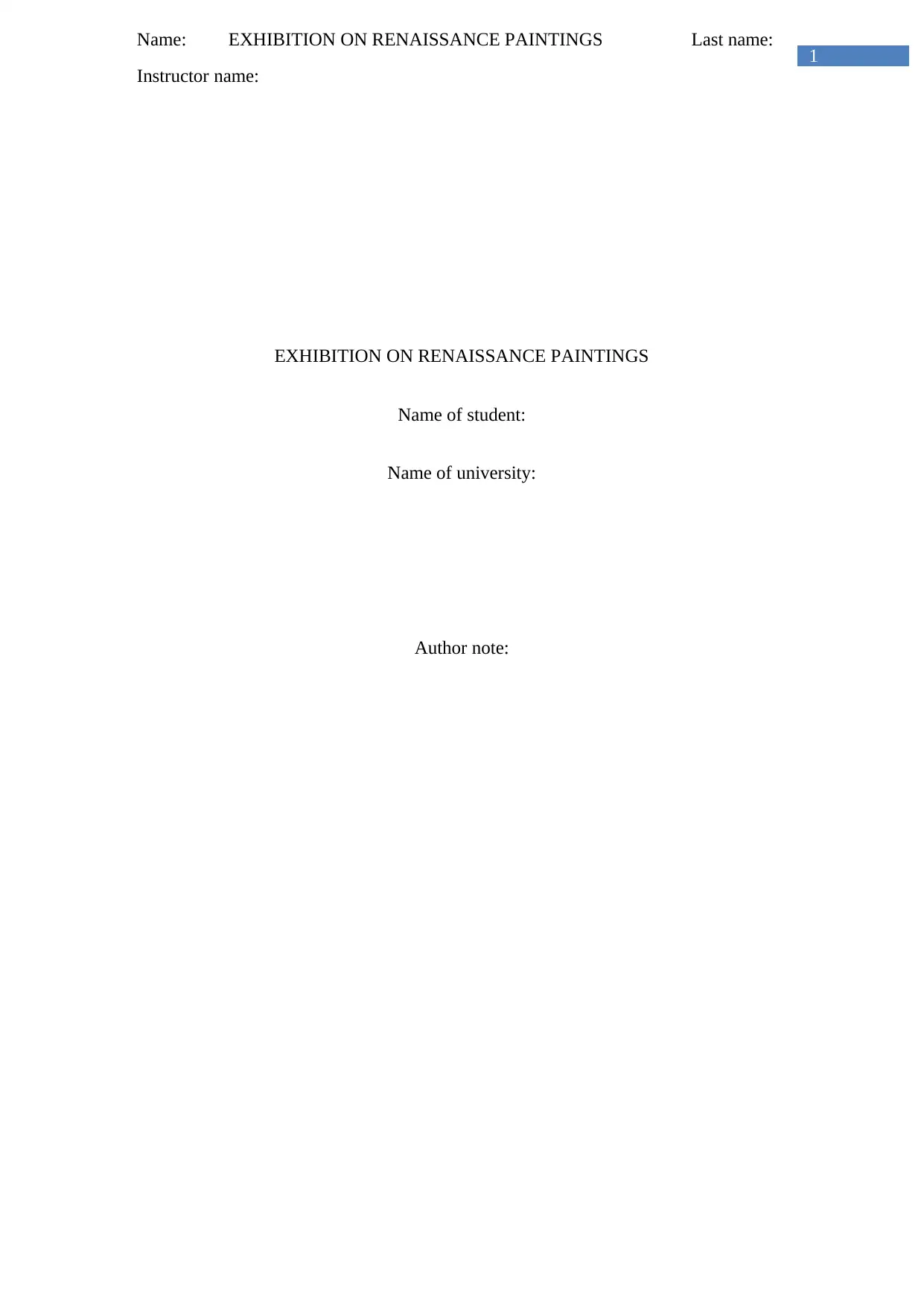
1
Name: EXHIBITION ON RENAISSANCE PAINTINGS Last name:
Instructor name:
EXHIBITION ON RENAISSANCE PAINTINGS
Name of student:
Name of university:
Author note:
Name: EXHIBITION ON RENAISSANCE PAINTINGS Last name:
Instructor name:
EXHIBITION ON RENAISSANCE PAINTINGS
Name of student:
Name of university:
Author note:
Paraphrase This Document
Need a fresh take? Get an instant paraphrase of this document with our AI Paraphraser
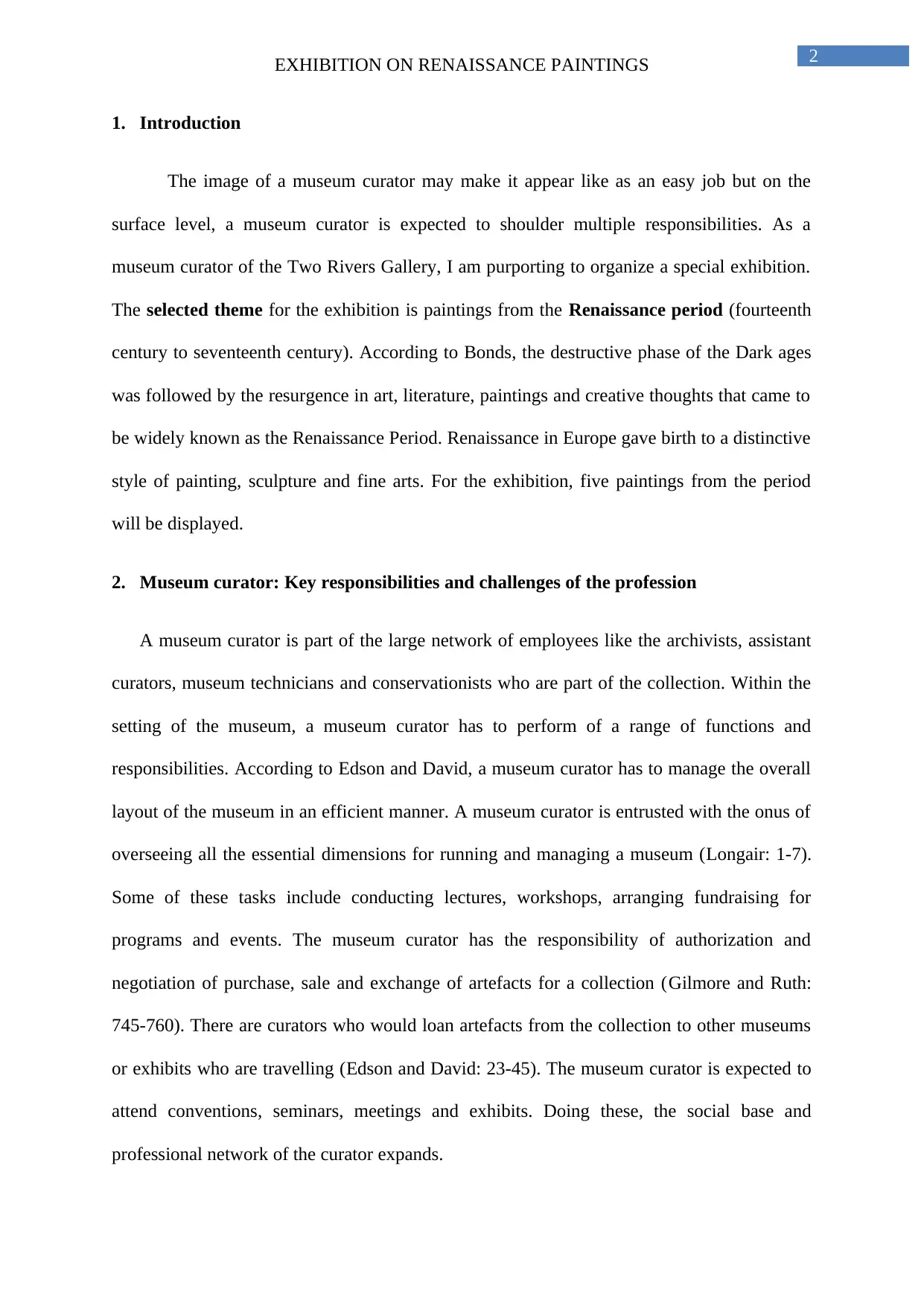
2EXHIBITION ON RENAISSANCE PAINTINGS
1. Introduction
The image of a museum curator may make it appear like as an easy job but on the
surface level, a museum curator is expected to shoulder multiple responsibilities. As a
museum curator of the Two Rivers Gallery, I am purporting to organize a special exhibition.
The selected theme for the exhibition is paintings from the Renaissance period (fourteenth
century to seventeenth century). According to Bonds, the destructive phase of the Dark ages
was followed by the resurgence in art, literature, paintings and creative thoughts that came to
be widely known as the Renaissance Period. Renaissance in Europe gave birth to a distinctive
style of painting, sculpture and fine arts. For the exhibition, five paintings from the period
will be displayed.
2. Museum curator: Key responsibilities and challenges of the profession
A museum curator is part of the large network of employees like the archivists, assistant
curators, museum technicians and conservationists who are part of the collection. Within the
setting of the museum, a museum curator has to perform of a range of functions and
responsibilities. According to Edson and David, a museum curator has to manage the overall
layout of the museum in an efficient manner. A museum curator is entrusted with the onus of
overseeing all the essential dimensions for running and managing a museum (Longair: 1-7).
Some of these tasks include conducting lectures, workshops, arranging fundraising for
programs and events. The museum curator has the responsibility of authorization and
negotiation of purchase, sale and exchange of artefacts for a collection (Gilmore and Ruth:
745-760). There are curators who would loan artefacts from the collection to other museums
or exhibits who are travelling (Edson and David: 23-45). The museum curator is expected to
attend conventions, seminars, meetings and exhibits. Doing these, the social base and
professional network of the curator expands.
1. Introduction
The image of a museum curator may make it appear like as an easy job but on the
surface level, a museum curator is expected to shoulder multiple responsibilities. As a
museum curator of the Two Rivers Gallery, I am purporting to organize a special exhibition.
The selected theme for the exhibition is paintings from the Renaissance period (fourteenth
century to seventeenth century). According to Bonds, the destructive phase of the Dark ages
was followed by the resurgence in art, literature, paintings and creative thoughts that came to
be widely known as the Renaissance Period. Renaissance in Europe gave birth to a distinctive
style of painting, sculpture and fine arts. For the exhibition, five paintings from the period
will be displayed.
2. Museum curator: Key responsibilities and challenges of the profession
A museum curator is part of the large network of employees like the archivists, assistant
curators, museum technicians and conservationists who are part of the collection. Within the
setting of the museum, a museum curator has to perform of a range of functions and
responsibilities. According to Edson and David, a museum curator has to manage the overall
layout of the museum in an efficient manner. A museum curator is entrusted with the onus of
overseeing all the essential dimensions for running and managing a museum (Longair: 1-7).
Some of these tasks include conducting lectures, workshops, arranging fundraising for
programs and events. The museum curator has the responsibility of authorization and
negotiation of purchase, sale and exchange of artefacts for a collection (Gilmore and Ruth:
745-760). There are curators who would loan artefacts from the collection to other museums
or exhibits who are travelling (Edson and David: 23-45). The museum curator is expected to
attend conventions, seminars, meetings and exhibits. Doing these, the social base and
professional network of the curator expands.
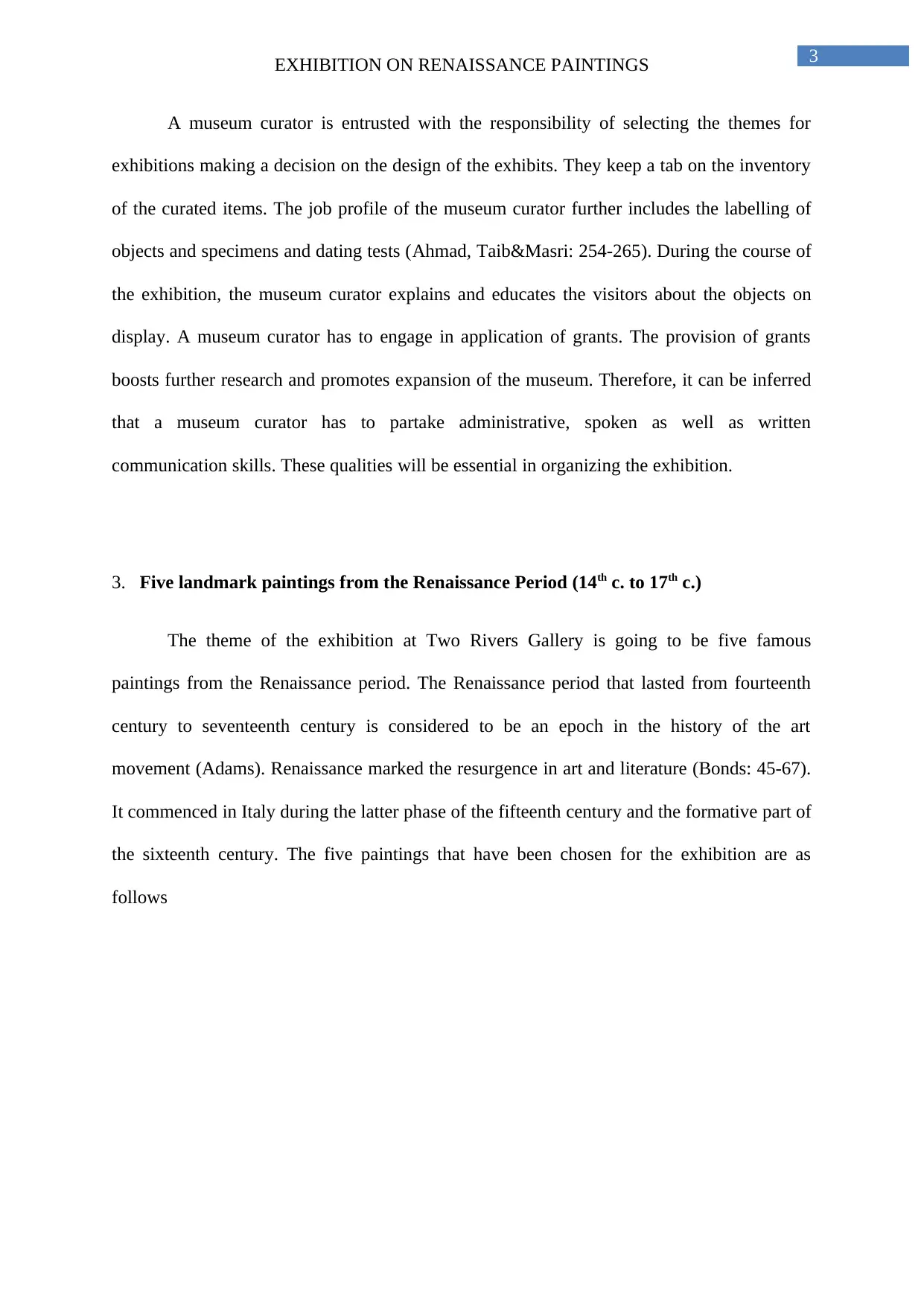
3EXHIBITION ON RENAISSANCE PAINTINGS
A museum curator is entrusted with the responsibility of selecting the themes for
exhibitions making a decision on the design of the exhibits. They keep a tab on the inventory
of the curated items. The job profile of the museum curator further includes the labelling of
objects and specimens and dating tests (Ahmad, Taib&Masri: 254-265). During the course of
the exhibition, the museum curator explains and educates the visitors about the objects on
display. A museum curator has to engage in application of grants. The provision of grants
boosts further research and promotes expansion of the museum. Therefore, it can be inferred
that a museum curator has to partake administrative, spoken as well as written
communication skills. These qualities will be essential in organizing the exhibition.
3. Five landmark paintings from the Renaissance Period (14th c. to 17th c.)
The theme of the exhibition at Two Rivers Gallery is going to be five famous
paintings from the Renaissance period. The Renaissance period that lasted from fourteenth
century to seventeenth century is considered to be an epoch in the history of the art
movement (Adams). Renaissance marked the resurgence in art and literature (Bonds: 45-67).
It commenced in Italy during the latter phase of the fifteenth century and the formative part of
the sixteenth century. The five paintings that have been chosen for the exhibition are as
follows
A museum curator is entrusted with the responsibility of selecting the themes for
exhibitions making a decision on the design of the exhibits. They keep a tab on the inventory
of the curated items. The job profile of the museum curator further includes the labelling of
objects and specimens and dating tests (Ahmad, Taib&Masri: 254-265). During the course of
the exhibition, the museum curator explains and educates the visitors about the objects on
display. A museum curator has to engage in application of grants. The provision of grants
boosts further research and promotes expansion of the museum. Therefore, it can be inferred
that a museum curator has to partake administrative, spoken as well as written
communication skills. These qualities will be essential in organizing the exhibition.
3. Five landmark paintings from the Renaissance Period (14th c. to 17th c.)
The theme of the exhibition at Two Rivers Gallery is going to be five famous
paintings from the Renaissance period. The Renaissance period that lasted from fourteenth
century to seventeenth century is considered to be an epoch in the history of the art
movement (Adams). Renaissance marked the resurgence in art and literature (Bonds: 45-67).
It commenced in Italy during the latter phase of the fifteenth century and the formative part of
the sixteenth century. The five paintings that have been chosen for the exhibition are as
follows
⊘ This is a preview!⊘
Do you want full access?
Subscribe today to unlock all pages.

Trusted by 1+ million students worldwide
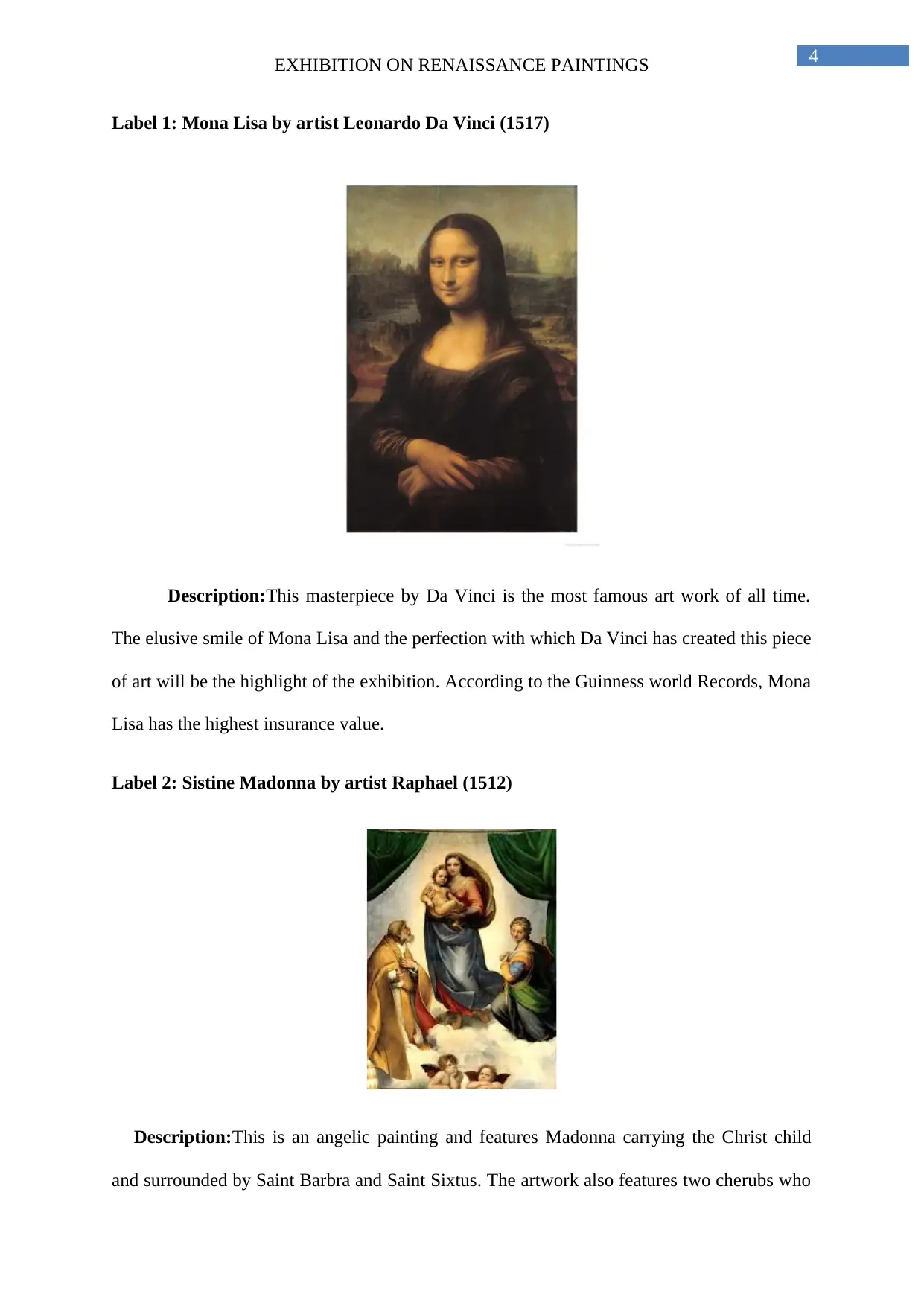
4EXHIBITION ON RENAISSANCE PAINTINGS
Label 1: Mona Lisa by artist Leonardo Da Vinci (1517)
Description:This masterpiece by Da Vinci is the most famous art work of all time.
The elusive smile of Mona Lisa and the perfection with which Da Vinci has created this piece
of art will be the highlight of the exhibition. According to the Guinness world Records, Mona
Lisa has the highest insurance value.
Label 2: Sistine Madonna by artist Raphael (1512)
Description:This is an angelic painting and features Madonna carrying the Christ child
and surrounded by Saint Barbra and Saint Sixtus. The artwork also features two cherubs who
Label 1: Mona Lisa by artist Leonardo Da Vinci (1517)
Description:This masterpiece by Da Vinci is the most famous art work of all time.
The elusive smile of Mona Lisa and the perfection with which Da Vinci has created this piece
of art will be the highlight of the exhibition. According to the Guinness world Records, Mona
Lisa has the highest insurance value.
Label 2: Sistine Madonna by artist Raphael (1512)
Description:This is an angelic painting and features Madonna carrying the Christ child
and surrounded by Saint Barbra and Saint Sixtus. The artwork also features two cherubs who
Paraphrase This Document
Need a fresh take? Get an instant paraphrase of this document with our AI Paraphraser
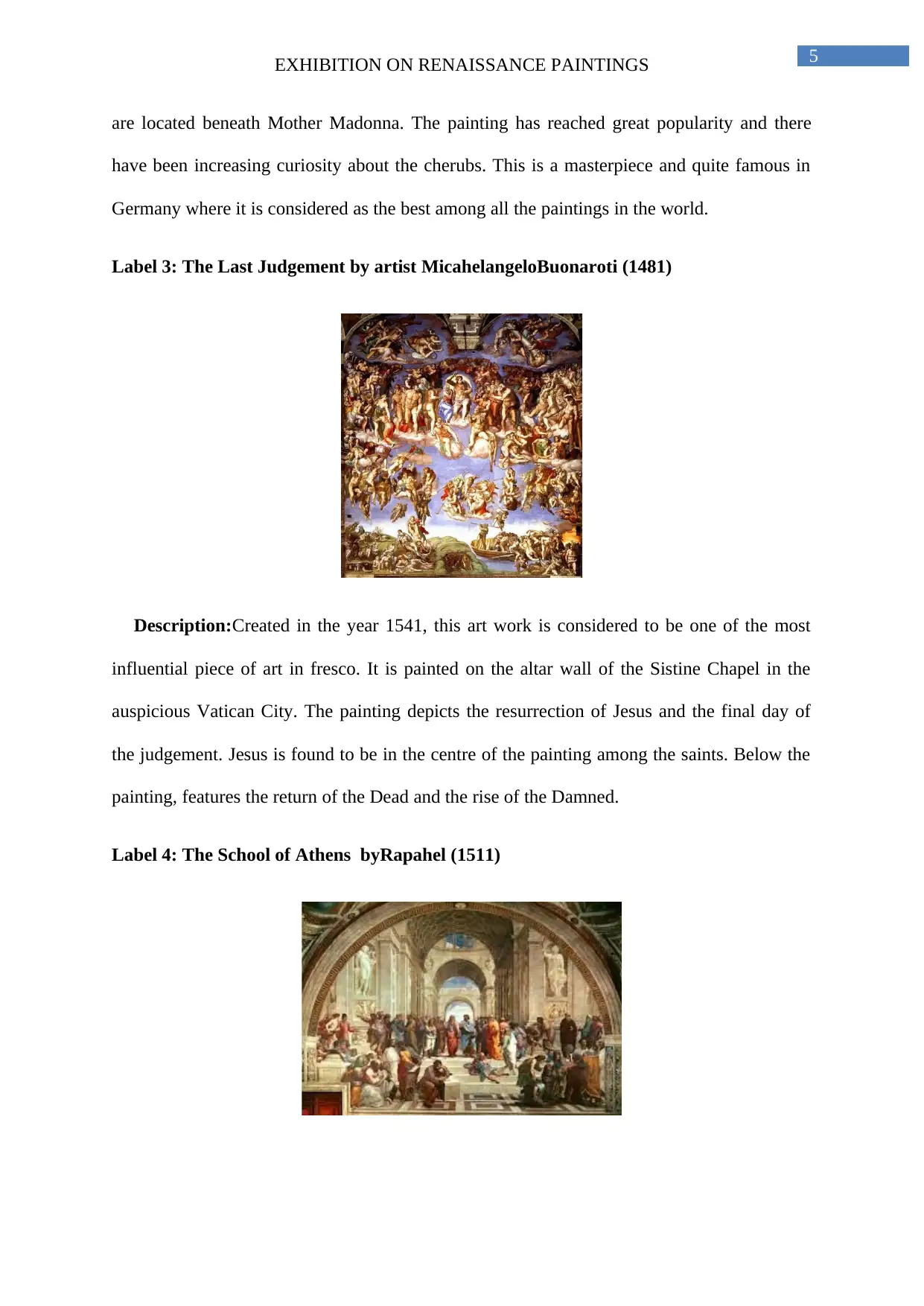
5EXHIBITION ON RENAISSANCE PAINTINGS
are located beneath Mother Madonna. The painting has reached great popularity and there
have been increasing curiosity about the cherubs. This is a masterpiece and quite famous in
Germany where it is considered as the best among all the paintings in the world.
Label 3: The Last Judgement by artist MicahelangeloBuonaroti (1481)
Description:Created in the year 1541, this art work is considered to be one of the most
influential piece of art in fresco. It is painted on the altar wall of the Sistine Chapel in the
auspicious Vatican City. The painting depicts the resurrection of Jesus and the final day of
the judgement. Jesus is found to be in the centre of the painting among the saints. Below the
painting, features the return of the Dead and the rise of the Damned.
Label 4: The School of Athens byRapahel (1511)
are located beneath Mother Madonna. The painting has reached great popularity and there
have been increasing curiosity about the cherubs. This is a masterpiece and quite famous in
Germany where it is considered as the best among all the paintings in the world.
Label 3: The Last Judgement by artist MicahelangeloBuonaroti (1481)
Description:Created in the year 1541, this art work is considered to be one of the most
influential piece of art in fresco. It is painted on the altar wall of the Sistine Chapel in the
auspicious Vatican City. The painting depicts the resurrection of Jesus and the final day of
the judgement. Jesus is found to be in the centre of the painting among the saints. Below the
painting, features the return of the Dead and the rise of the Damned.
Label 4: The School of Athens byRapahel (1511)
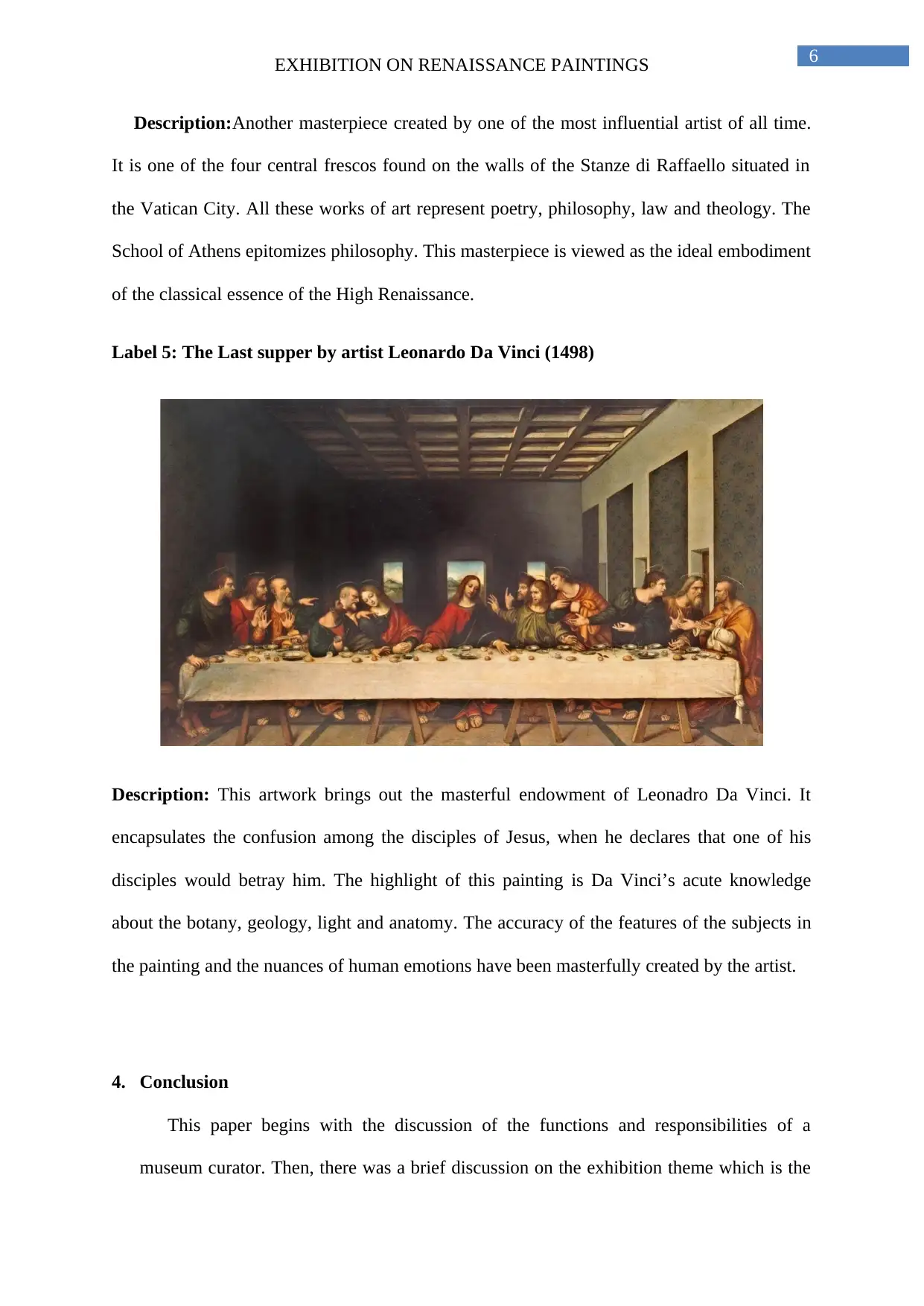
6EXHIBITION ON RENAISSANCE PAINTINGS
Description:Another masterpiece created by one of the most influential artist of all time.
It is one of the four central frescos found on the walls of the Stanze di Raffaello situated in
the Vatican City. All these works of art represent poetry, philosophy, law and theology. The
School of Athens epitomizes philosophy. This masterpiece is viewed as the ideal embodiment
of the classical essence of the High Renaissance.
Label 5: The Last supper by artist Leonardo Da Vinci (1498)
Description: This artwork brings out the masterful endowment of Leonadro Da Vinci. It
encapsulates the confusion among the disciples of Jesus, when he declares that one of his
disciples would betray him. The highlight of this painting is Da Vinci’s acute knowledge
about the botany, geology, light and anatomy. The accuracy of the features of the subjects in
the painting and the nuances of human emotions have been masterfully created by the artist.
4. Conclusion
This paper begins with the discussion of the functions and responsibilities of a
museum curator. Then, there was a brief discussion on the exhibition theme which is the
Description:Another masterpiece created by one of the most influential artist of all time.
It is one of the four central frescos found on the walls of the Stanze di Raffaello situated in
the Vatican City. All these works of art represent poetry, philosophy, law and theology. The
School of Athens epitomizes philosophy. This masterpiece is viewed as the ideal embodiment
of the classical essence of the High Renaissance.
Label 5: The Last supper by artist Leonardo Da Vinci (1498)
Description: This artwork brings out the masterful endowment of Leonadro Da Vinci. It
encapsulates the confusion among the disciples of Jesus, when he declares that one of his
disciples would betray him. The highlight of this painting is Da Vinci’s acute knowledge
about the botany, geology, light and anatomy. The accuracy of the features of the subjects in
the painting and the nuances of human emotions have been masterfully created by the artist.
4. Conclusion
This paper begins with the discussion of the functions and responsibilities of a
museum curator. Then, there was a brief discussion on the exhibition theme which is the
⊘ This is a preview!⊘
Do you want full access?
Subscribe today to unlock all pages.

Trusted by 1+ million students worldwide
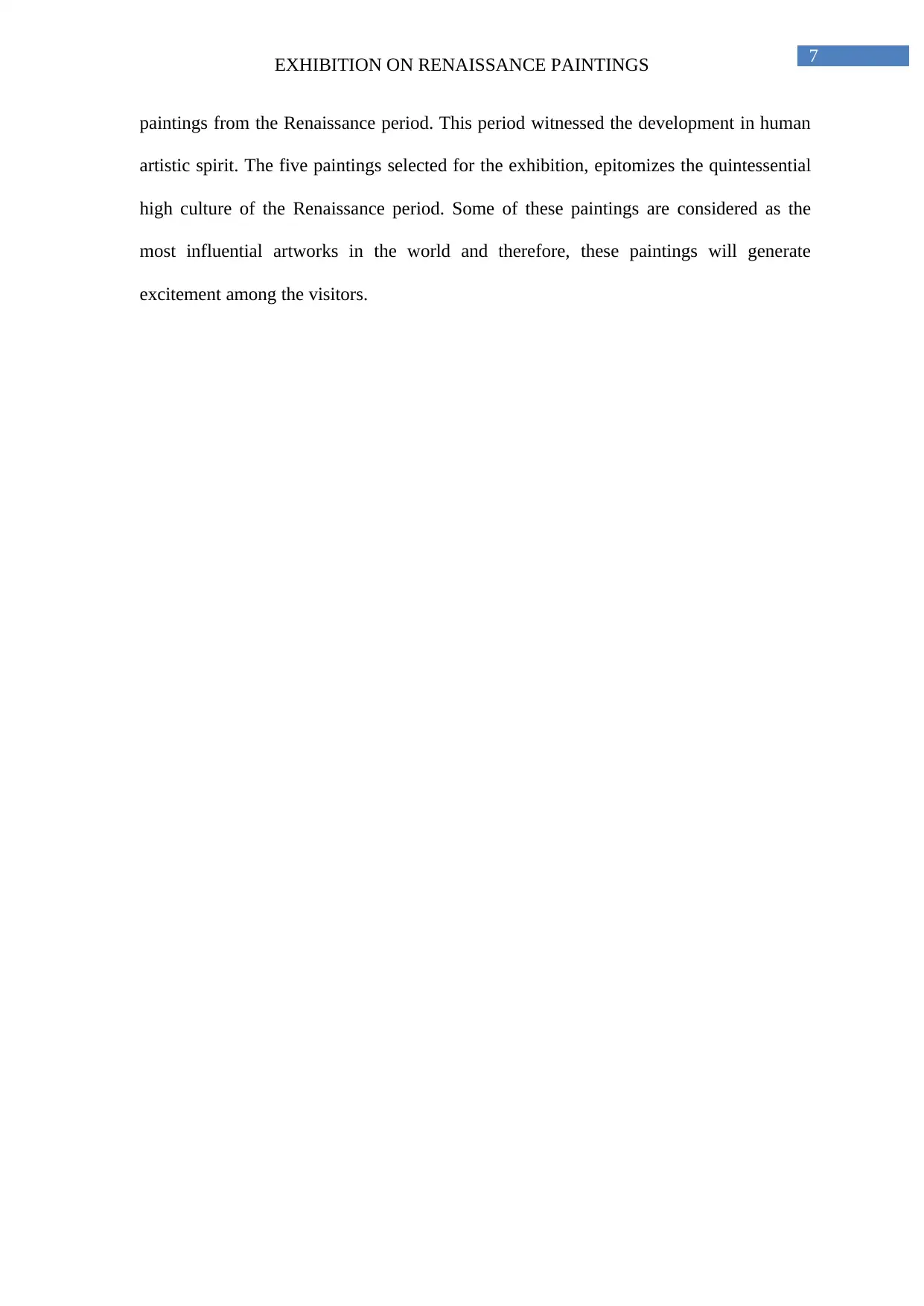
7EXHIBITION ON RENAISSANCE PAINTINGS
paintings from the Renaissance period. This period witnessed the development in human
artistic spirit. The five paintings selected for the exhibition, epitomizes the quintessential
high culture of the Renaissance period. Some of these paintings are considered as the
most influential artworks in the world and therefore, these paintings will generate
excitement among the visitors.
paintings from the Renaissance period. This period witnessed the development in human
artistic spirit. The five paintings selected for the exhibition, epitomizes the quintessential
high culture of the Renaissance period. Some of these paintings are considered as the
most influential artworks in the world and therefore, these paintings will generate
excitement among the visitors.
Paraphrase This Document
Need a fresh take? Get an instant paraphrase of this document with our AI Paraphraser
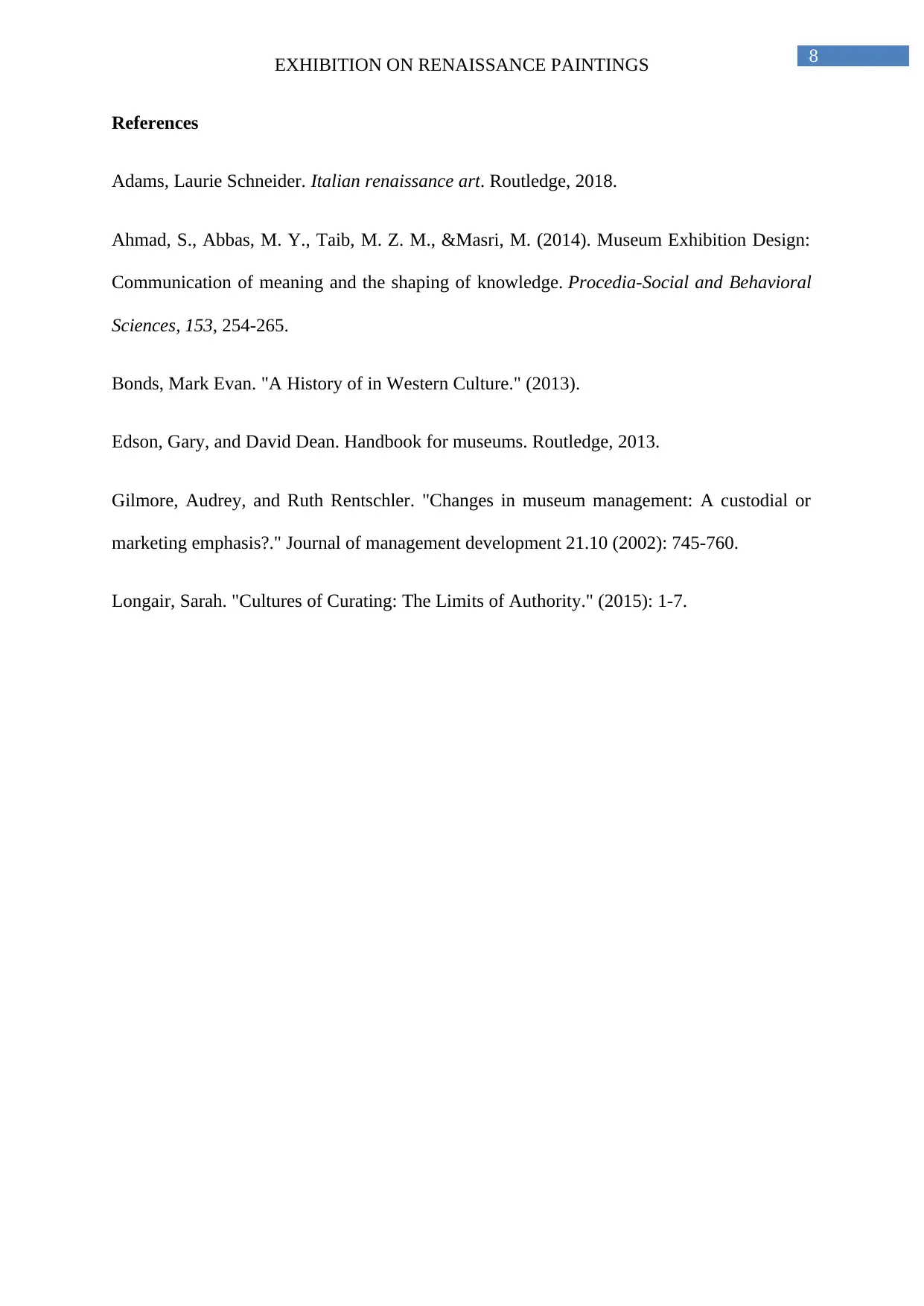
8EXHIBITION ON RENAISSANCE PAINTINGS
References
Adams, Laurie Schneider. Italian renaissance art. Routledge, 2018.
Ahmad, S., Abbas, M. Y., Taib, M. Z. M., &Masri, M. (2014). Museum Exhibition Design:
Communication of meaning and the shaping of knowledge. Procedia-Social and Behavioral
Sciences, 153, 254-265.
Bonds, Mark Evan. "A History of in Western Culture." (2013).
Edson, Gary, and David Dean. Handbook for museums. Routledge, 2013.
Gilmore, Audrey, and Ruth Rentschler. "Changes in museum management: A custodial or
marketing emphasis?." Journal of management development 21.10 (2002): 745-760.
Longair, Sarah. "Cultures of Curating: The Limits of Authority." (2015): 1-7.
References
Adams, Laurie Schneider. Italian renaissance art. Routledge, 2018.
Ahmad, S., Abbas, M. Y., Taib, M. Z. M., &Masri, M. (2014). Museum Exhibition Design:
Communication of meaning and the shaping of knowledge. Procedia-Social and Behavioral
Sciences, 153, 254-265.
Bonds, Mark Evan. "A History of in Western Culture." (2013).
Edson, Gary, and David Dean. Handbook for museums. Routledge, 2013.
Gilmore, Audrey, and Ruth Rentschler. "Changes in museum management: A custodial or
marketing emphasis?." Journal of management development 21.10 (2002): 745-760.
Longair, Sarah. "Cultures of Curating: The Limits of Authority." (2015): 1-7.
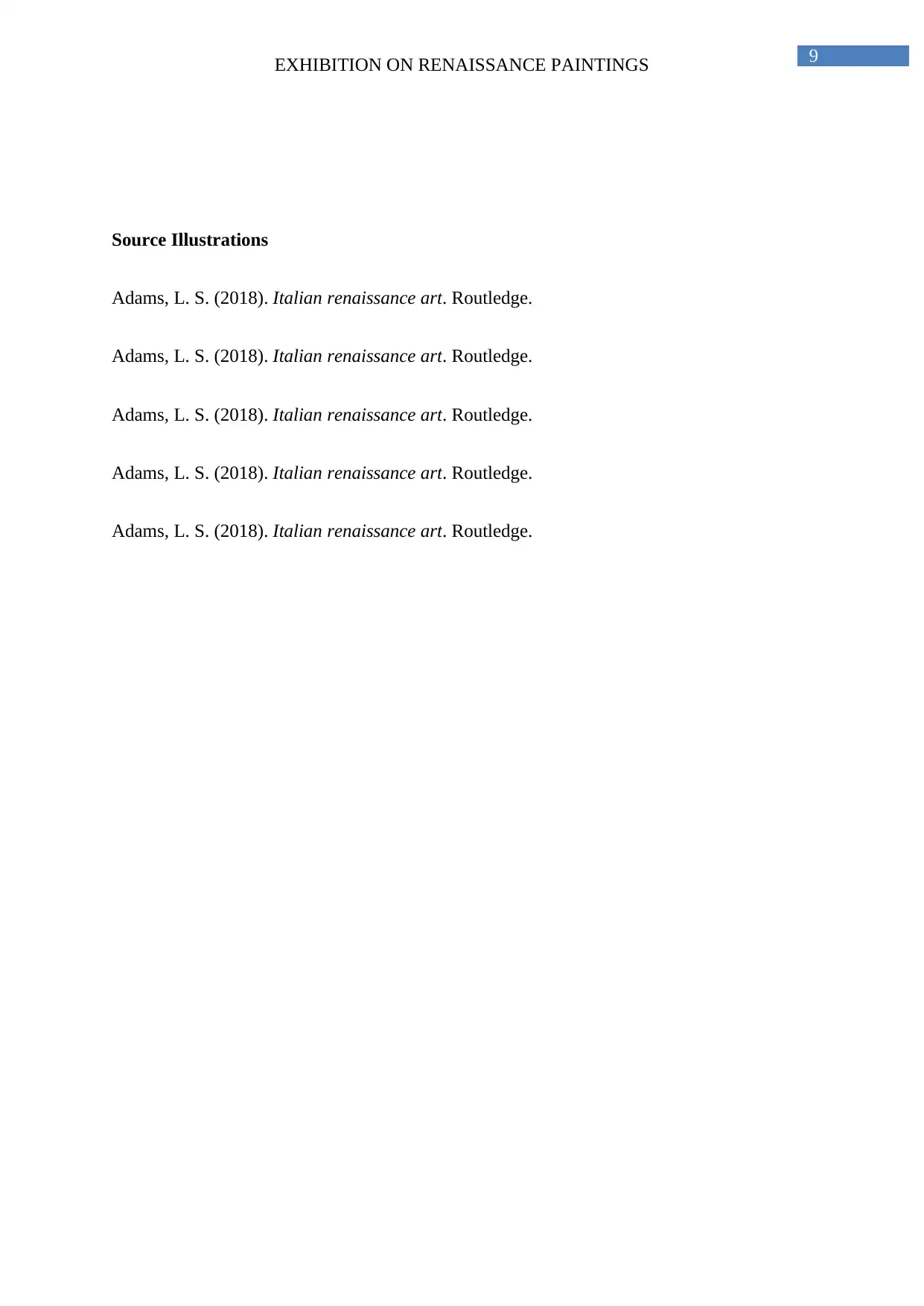
9EXHIBITION ON RENAISSANCE PAINTINGS
Source Illustrations
Adams, L. S. (2018). Italian renaissance art. Routledge.
Adams, L. S. (2018). Italian renaissance art. Routledge.
Adams, L. S. (2018). Italian renaissance art. Routledge.
Adams, L. S. (2018). Italian renaissance art. Routledge.
Adams, L. S. (2018). Italian renaissance art. Routledge.
Source Illustrations
Adams, L. S. (2018). Italian renaissance art. Routledge.
Adams, L. S. (2018). Italian renaissance art. Routledge.
Adams, L. S. (2018). Italian renaissance art. Routledge.
Adams, L. S. (2018). Italian renaissance art. Routledge.
Adams, L. S. (2018). Italian renaissance art. Routledge.
⊘ This is a preview!⊘
Do you want full access?
Subscribe today to unlock all pages.

Trusted by 1+ million students worldwide
1 out of 9
Related Documents
Your All-in-One AI-Powered Toolkit for Academic Success.
+13062052269
info@desklib.com
Available 24*7 on WhatsApp / Email
![[object Object]](/_next/static/media/star-bottom.7253800d.svg)
Unlock your academic potential
Copyright © 2020–2025 A2Z Services. All Rights Reserved. Developed and managed by ZUCOL.





